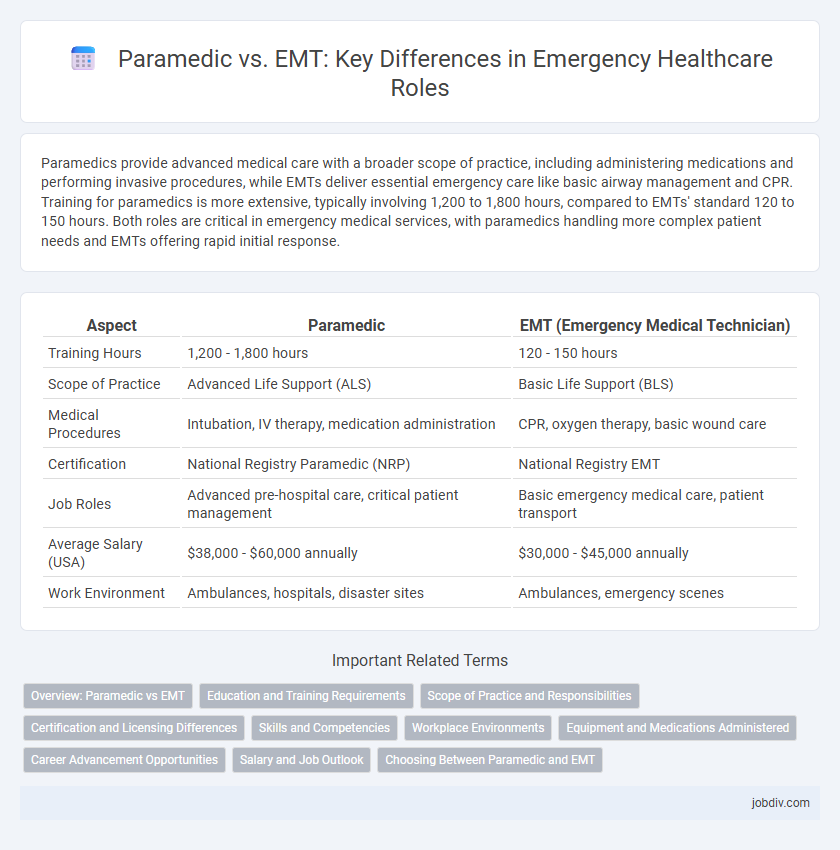Paramedics provide advanced medical care with a broader scope of practice, including administering medications and performing invasive procedures, while EMTs deliver essential emergency care like basic airway management and CPR. Training for paramedics is more extensive, typically involving 1,200 to 1,800 hours, compared to EMTs' standard 120 to 150 hours. Both roles are critical in emergency medical services, with paramedics handling more complex patient needs and EMTs offering rapid initial response.
Table of Comparison
| Aspect | Paramedic | EMT (Emergency Medical Technician) |
|---|---|---|
| Training Hours | 1,200 - 1,800 hours | 120 - 150 hours |
| Scope of Practice | Advanced Life Support (ALS) | Basic Life Support (BLS) |
| Medical Procedures | Intubation, IV therapy, medication administration | CPR, oxygen therapy, basic wound care |
| Certification | National Registry Paramedic (NRP) | National Registry EMT |
| Job Roles | Advanced pre-hospital care, critical patient management | Basic emergency medical care, patient transport |
| Average Salary (USA) | $38,000 - $60,000 annually | $30,000 - $45,000 annually |
| Work Environment | Ambulances, hospitals, disaster sites | Ambulances, emergency scenes |
Overview: Paramedic vs EMT
Paramedics provide advanced medical care, including administering medications, performing intubations, and interpreting EKGs, while EMTs deliver basic life support such as CPR, bandaging wounds, and oxygen administration. Paramedics undergo more extensive training, often exceeding 1,200 hours, compared to the 120-150 hours required for EMT certification. The scope of practice for paramedics enables them to handle complex emergencies and stabilize patients before hospital transport, whereas EMTs focus on urgent care and rapid patient assessment.
Education and Training Requirements
Paramedics require completion of an accredited paramedic program, typically involving 1,200 to 1,800 hours of training that includes advanced life support, pharmacology, and cardiology. EMTs must complete a state-approved basic EMT course, usually requiring 120 to 150 hours, focusing on foundational emergency care and patient assessment. Paramedics undergo more extensive clinical and field internships, preparing them for higher-level medical procedures beyond the EMT scope.
Scope of Practice and Responsibilities
Paramedics possess a broader scope of practice compared to EMTs, including advanced airway management, administering medications, and performing invasive procedures such as intubation. EMTs provide basic emergency care like CPR, oxygen administration, and wound treatment, focusing primarily on stabilizing patients for transport. The expanded responsibilities of paramedics enable them to handle more complex medical emergencies and deliver advanced life support on the scene.
Certification and Licensing Differences
Paramedics require advanced certification such as the National Registry of Emergency Medical Technicians (NREMT) paramedic credential, involving extensive training in advanced life support, pharmacology, and patient assessment, typically completed in 1,200 to 1,800 hours. EMTs obtain basic certification through the NREMT EMT exam, focusing on fundamental emergency care skills with approximately 120 to 150 hours of training. Licensing for paramedics demands state-level approval demonstrating proficiency in advanced procedures, whereas EMT licensing involves certification for basic airway management and CPR techniques.
Skills and Competencies
Paramedics possess advanced skills including intravenous therapy, medication administration, and advanced airway management, enabling them to perform complex medical procedures in emergency situations. EMTs focus on basic life support competencies such as patient assessment, CPR, wound care, and oxygen administration, providing essential pre-hospital care. The competencies of paramedics encompass critical decision-making and advanced diagnostic techniques, while EMTs ensure stable patient conditions during transport.
Workplace Environments
Paramedics often work in high-stress environments such as ambulances, emergency rooms, and disaster sites where advanced medical interventions are required. EMTs typically operate in pre-hospital settings, including ambulances and community events, providing basic life support and stabilizing patients for transport. Both roles demand quick decision-making and strong teamwork but differ in the complexity of medical procedures performed on-site.
Equipment and Medications Administered
Paramedics possess advanced equipment such as cardiac monitors, defibrillators, and advanced airway management tools, enabling them to perform complex procedures including intubation and intravenous therapy. They are authorized to administer a wider range of medications like epinephrine, pain relievers, and cardiac drugs. EMTs typically use basic life support tools including oxygen delivery systems, automated external defibrillators, and splints, and provide limited medications such as oxygen, glucose, and epinephrine auto-injectors.
Career Advancement Opportunities
Paramedics have a broader scope of practice and higher education requirements, enabling them to access advanced career opportunities in critical care transport, emergency nursing, or physician assistant roles. EMTs typically pursue certification as paramedics to enhance their skills and increase career advancement potential. Specialized training and certifications in advanced life support significantly improve upward mobility in emergency medical services and related healthcare fields.
Salary and Job Outlook
Paramedics typically earn higher salaries than EMTs, with the U.S. Bureau of Labor Statistics reporting a median annual wage of approximately $38,000 for EMTs and $47,000 for paramedics as of 2023. Employment growth for paramedics is projected at 6% from 2022 to 2032, reflecting a faster-than-average demand due to an aging population and increased emergency medical services needs. EMT job outlook remains steady, with opportunities concentrated in urban and suburban areas where quick emergency response is critical.
Choosing Between Paramedic and EMT
Choosing between a paramedic and an EMT depends on the level of emergency medical care required and the scope of practice. Paramedics possess advanced training in cardiac life support, medication administration, and invasive procedures, making them essential for critical emergencies, whereas EMTs provide basic life support, including CPR, oxygen therapy, and wound management. Assessing patient needs, available resources, and the complexity of medical intervention guides the decision toward an EMT or paramedic during emergency response.
Paramedic vs EMT Infographic

 jobdiv.com
jobdiv.com